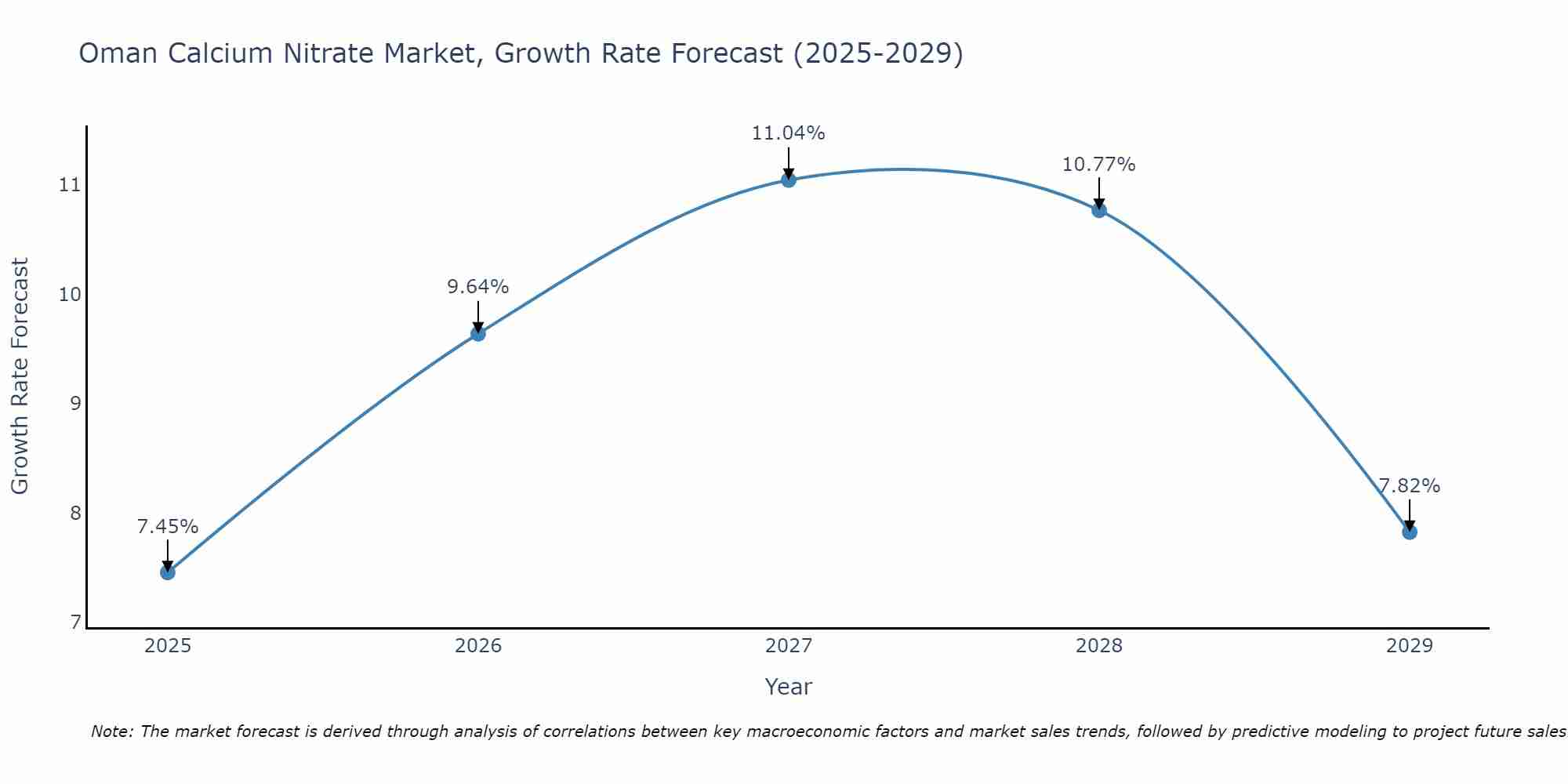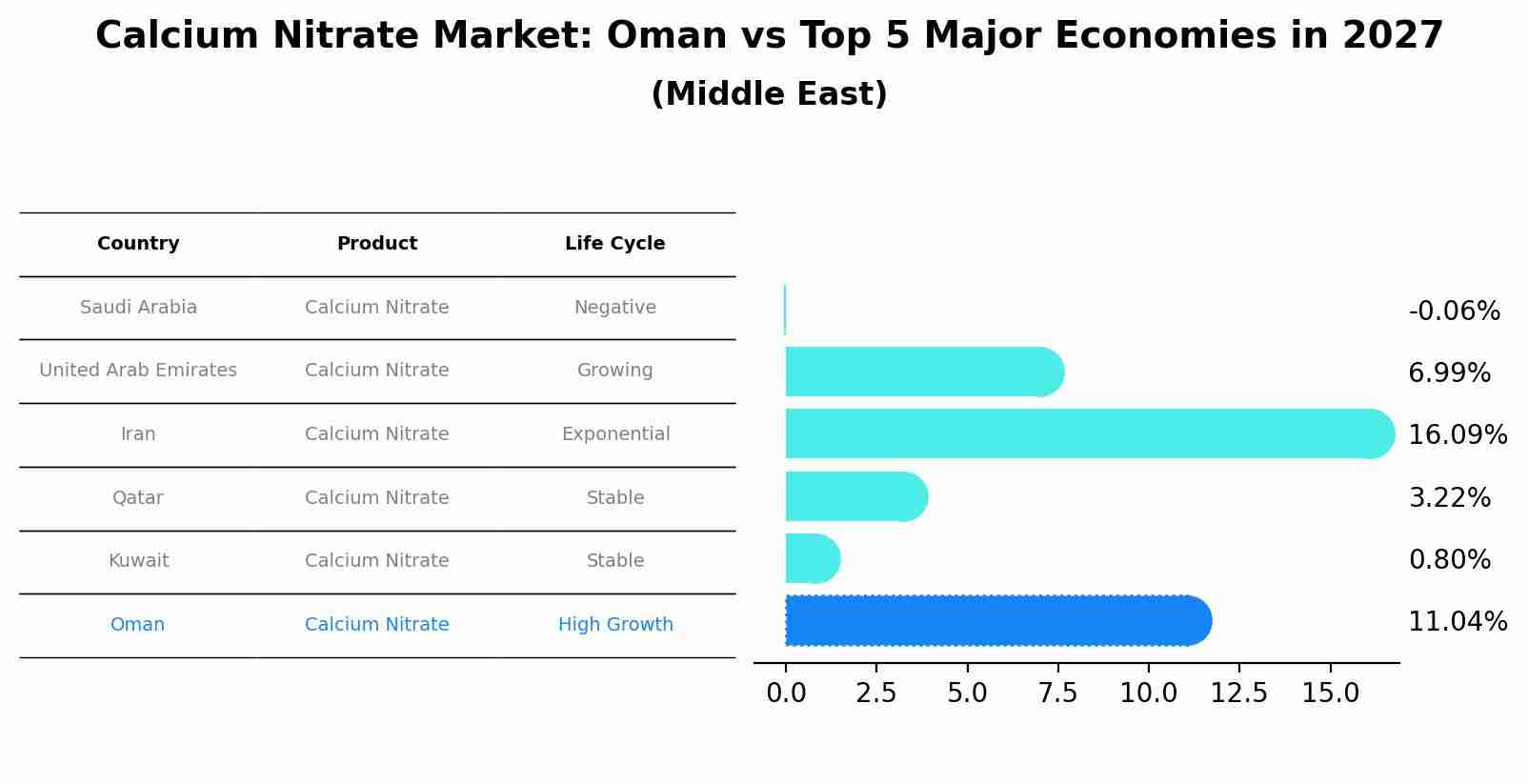Oman Calcium Nitrate Market (2025-2031) Outlook | Size, Forecast, Growth, Companies, Analysis, Trends, Revenue, Value, Industry & Share
| Product Code: ETC093482 | Publication Date: Jun 2021 | Updated Date: Apr 2025 | Product Type: Report | |
| Publisher: 6Wresearch | Author: Ravi Bhandari | No. of Pages: 70 | No. of Figures: 35 | No. of Tables: 5 |
Oman Calcium Nitrate Market Size Growth Rate
The Oman Calcium Nitrate Market is projected to witness mixed growth rate patterns during 2025 to 2029. Growth accelerates to 11.04% in 2027, following an initial rate of 7.45%, before easing to 7.82% at the end of the period.

Calcium Nitrate Market: Oman vs Top 5 Major Economies in 2027 (Middle East)
By 2027, the Calcium Nitrate market in Oman is anticipated to reach a growth rate of 11.04%, as part of an increasingly competitive Middle East region, where Saudi Arabia remains at the forefront, supported by United Arab Emirates, Iran, Qatar and Kuwait, driving innovations and market adoption across sectors.

Oman Calcium Nitrate Market Overview
In Oman, the calcium nitrate market is primarily influenced by the agricultural sector, where it is used as a nitrogen fertilizer to enhance crop yield and soil fertility. The increasing focus on modern farming techniques and the need to improve agricultural productivity are key factors propelling the market growth. Additionally, calcium nitrate is used in concrete manufacturing to speed up the setting process, supporting its demand in the construction industry.
Drivers of the market
The Oman calcium nitrate market is driven by its critical role in the agricultural sector as a fertilizer. The demand is bolstered by the need to improve crop yields and quality in a region with challenging soil conditions. Additionally, calcium nitrate is used in wastewater treatment and concrete manufacturing, enhancing its market appeal. The growing emphasis on sustainable agricultural practices and the development of modern farming techniques also contribute significantly to the increasing demand for calcium nitrate in Oman.
Challenges of the market
Challenges in the Oman calcium nitrate market stem from its heavy reliance on the agricultural sector, which is subject to varying climatic conditions and economic factors. The market faces competition from other fertilizers, which can impact demand. Additionally, the cost of production is influenced by the availability and price of raw materials, such as limestone and nitric acid. Import dependency and logistics issues further exacerbate the market`s vulnerability, making it susceptible to international market fluctuations and supply chain disruptions.
Government Policy of the market
Agricultural policies in Oman focus on improving crop yield and soil fertility, supporting the use of calcium nitrate as a fertilizer. The government provides subsidies and training programs to farmers to adopt modern fertilization techniques. These initiatives are part of a broader strategy to enhance food security and reduce dependence on food imports.
Key Highlights of the Report:
- Oman Calcium Nitrate Market Outlook
- Market Size of Oman Calcium Nitrate Market, 2024
- Forecast of Oman Calcium Nitrate Market, 2031
- Historical Data and Forecast of Oman Calcium Nitrate Revenues & Volume for the Period 2021-2031
- Oman Calcium Nitrate Market Trend Evolution
- Oman Calcium Nitrate Market Drivers and Challenges
- Oman Calcium Nitrate Price Trends
- Oman Calcium Nitrate Porter's Five Forces
- Oman Calcium Nitrate Industry Life Cycle
- Historical Data and Forecast of Oman Calcium Nitrate Market Revenues & Volume By Grade for the Period 2021-2031
- Historical Data and Forecast of Oman Calcium Nitrate Market Revenues & Volume By Agriculture for the Period 2021-2031
- Historical Data and Forecast of Oman Calcium Nitrate Market Revenues & Volume By Greenhouse for the Period 2021-2031
- Historical Data and Forecast of Oman Calcium Nitrate Market Revenues & Volume By Fertigation for the Period 2021-2031
- Historical Data and Forecast of Oman Calcium Nitrate Market Revenues & Volume By Liquid for the Period 2021-2031
- Historical Data and Forecast of Oman Calcium Nitrate Market Revenues & Volume By Application for the Period 2021-2031
- Historical Data and Forecast of Oman Calcium Nitrate Market Revenues & Volume By Fertilizers for the Period 2021-2031
- Historical Data and Forecast of Oman Calcium Nitrate Market Revenues & Volume By Wastewater Treatment Chemicals for the Period 2021-2031
- Historical Data and Forecast of Oman Calcium Nitrate Market Revenues & Volume By Concrete Manufacturing for the Period 2021-2031
- Historical Data and Forecast of Oman Calcium Nitrate Market Revenues & Volume By Explosives for the Period 2021-2031
- Oman Calcium Nitrate Import Export Trade Statistics
- Market Opportunity Assessment By Grade
- Market Opportunity Assessment By Application
- Oman Calcium Nitrate Top Companies Market Share
- Oman Calcium Nitrate Competitive Benchmarking By Technical and Operational Parameters
- Oman Calcium Nitrate Company Profiles
- Oman Calcium Nitrate Key Strategic Recommendations
Frequently Asked Questions About the Market Study (FAQs):
- Single User License$ 1,995
- Department License$ 2,400
- Site License$ 3,120
- Global License$ 3,795
Search
Thought Leadership and Analyst Meet
Our Clients
Related Reports
- Canada Oil and Gas Market (2026-2032) | Share, Segmentation, Value, Industry, Trends, Forecast, Analysis, Size & Revenue, Growth, Competitive Landscape, Outlook, Companies
- Germany Breakfast Food Market (2026-2032) | Industry, Share, Growth, Size, Companies, Value, Analysis, Revenue, Trends, Forecast & Outlook
- Australia Briquette Market (2025-2031) | Growth, Size, Revenue, Forecast, Analysis, Trends, Value, Share, Industry & Companies
- Vietnam System Integrator Market (2025-2031) | Size, Companies, Analysis, Industry, Value, Forecast, Growth, Trends, Revenue & Share
- ASEAN and Thailand Brain Health Supplements Market (2025-2031) | Strategy, Consumer Insights, Analysis, Investment Trends, Opportunities, Growth, Size, Share, Industry, Revenue, Segments, Value, Segmentation, Supply, Forecast, Restraints, Outlook, Competition, Drivers, Trends, Demand, Pricing Analysis, Competitive, Strategic Insights, Companies, Challenges
- ASEAN Bearings Market (2025-2031) | Strategy, Consumer Insights, Analysis, Investment Trends, Opportunities, Growth, Size, Share, Industry, Revenue, Segments, Value, Segmentation, Supply, Forecast, Restraints, Outlook, Competition, Drivers, Trends, Demand, Pricing Analysis, Competitive, Strategic Insights, Companies, Challenges
- Europe Flooring Market (2025-2031) | Outlook, Share, Industry, Trends, Forecast, Companies, Revenue, Size, Analysis, Growth & Value
- Saudi Arabia Manlift Market (2025-2031) | Outlook, Size, Growth, Trends, Companies, Industry, Revenue, Value, Share, Forecast & Analysis
- Uganda Excavator, Crane, and Wheel Loaders Market (2025-2031) | Strategy, Consumer Insights, Analysis, Investment Trends, Opportunities, Growth, Size, Share, Industry, Revenue, Segments, Value, Segmentation, Supply, Forecast, Restraints, Outlook, Competition, Drivers, Trends, Demand, Pricing Analysis, Competitive, Strategic Insights, Companies, Challenges
- Rwanda Excavator, Crane, and Wheel Loaders Market (2025-2031) | Strategy, Consumer Insights, Analysis, Investment Trends, Opportunities, Growth, Size, Share, Industry, Revenue, Segments, Value, Segmentation, Supply, Forecast, Restraints, Outlook, Competition, Drivers, Trends, Demand, Pricing Analysis, Competitive, Strategic Insights, Companies, Challenges
Industry Events and Analyst Meet
Whitepaper
- Middle East & Africa Commercial Security Market Click here to view more.
- Middle East & Africa Fire Safety Systems & Equipment Market Click here to view more.
- GCC Drone Market Click here to view more.
- Middle East Lighting Fixture Market Click here to view more.
- GCC Physical & Perimeter Security Market Click here to view more.
6WResearch In News
- Doha a strategic location for EV manufacturing hub: IPA Qatar
- Demand for luxury TVs surging in the GCC, says Samsung
- Empowering Growth: The Thriving Journey of Bangladesh’s Cable Industry
- Demand for luxury TVs surging in the GCC, says Samsung
- Video call with a traditional healer? Once unthinkable, it’s now common in South Africa
- Intelligent Buildings To Smooth GCC’s Path To Net Zero


















